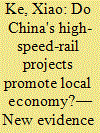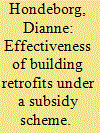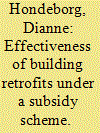|
|
|
Sort Order |
|
|
|
Items / Page
|
|
|
|
|
|
|
| Srl | Item |
| 1 |
ID:
159056


|
|
|
|
|
| Summary/Abstract |
This paper evaluates the effect of High Speed Rail (HSR) projects on the economic growth of targeted city nodes (HSR cities) in China using prefectural-level city data from 1990 to 2013. Employing a panel data program evaluation method devised by Hsiao, Ching, and Wan (2012), we construct hypothetical counterfactuals for per capita real GDP of HSR cities in the absence of their respective HSR projects using the outcomes in selected non-HSR cities. We find that the responses to HSR treatment are heterogeneous with regard to location, route, and region. The location-level impact ranges between 5% and 59% and is not temporary. HSR cities with positive effects concentrate along the Hu-Ning Segment, the Yong-Tai-Wen-Fu-Xia Segment, and within the Hunan province along the Wu-Guang HSR. These cities are mainly located in the eastern coastal regions of China, in core urban agglomeration regions that allow them to be transportation hubs. In general, the gain for local economies is greater for cities that are more industrialized, with more ability of the service sector to absorb enough labor, and with better supporting infrastructure. On the other hand, local protectionism hampers the development of HSR cities. We also show that at different project stages, HSR cities experience different gains.
|
|
|
|
|
|
|
|
|
|
|
|
|
|
|
|
| 2 |
ID:
191366


|
|
|
|
|
| Summary/Abstract |
While retrofitting buildings is one of the key elements of reaching climate and energy goals, it is burdened by insufficient speed and depth. Governments have attempted to accelerate deep retrofits via subsidies, but scant evidence exists on these policies’ effectiveness. In this study, we investigate the effectiveness of retrofitting subsidies by using a range of econometric techniques and a unique dataset of over 400 Swiss buildings with 19,000 observations over 11 years. Specifically, we analyze whether retrofits reduce energy consumption, whether subsidized retrofits lead to deeper retrofits than non-subsidized retrofits, and we differentiate the impact by subsidy amount. We find that retrofits reduce average energy use by 10–20%, that the achieved savings through subsidized and non-subsidized retrofits do not differ significantly, and that the subsidy amount is correlated to a reduction in energy use by 0.42 CHF per kWh over a period of 20 years. Our study highlights the importance of policies that enhance retrofit depth, the need to further investigate the causes of the wide variation in retrofitting results, and to consider effectiveness studies within the policy design.
|
|
|
|
|
|
|
|
|
|
|
|
|
|
|
|
| 3 |
ID:
192761


|
|
|
|
|
| Summary/Abstract |
While retrofitting buildings is one of the key elements of reaching climate and energy goals, it is burdened by insufficient speed and depth. Governments have attempted to accelerate deep retrofits via subsidies, but scant evidence exists on these policies’ effectiveness. In this study, we investigate the effectiveness of retrofitting subsidies by using a range of econometric techniques and a unique dataset of over 400 Swiss buildings with 19,000 observations over 11 years. Specifically, we analyze whether retrofits reduce energy consumption, whether subsidized retrofits lead to deeper retrofits than non-subsidized retrofits, and we differentiate the impact by subsidy amount. We find that retrofits reduce average energy use by 10–20%, that the achieved savings through subsidized and non-subsidized retrofits do not differ significantly, and that the subsidy amount is correlated to a reduction in energy use by 0.42 CHF per kWh over a period of 20 years. Our study highlights the importance of policies that enhance retrofit depth, the need to further investigate the causes of the wide variation in retrofitting results, and to consider effectiveness studies within the policy design.
|
|
|
|
|
|
|
|
|
|
|
|
|
|
|
|
| 4 |
ID:
192372


|
|
|
|
|
| Summary/Abstract |
Reducing urban-rural gaps in child health is one of the most difficult challenges faced by many countries. This paper evaluates the impact of a large-scale school meal program in rural China on the health and nutritional status of students aged 6–16 in compulsory education. We use data from the China Health and Nutrition Survey corresponding to four pre-treatment years (2004, 2006, 2009, and 2011) and one post-treatment year (2015) and find that program participation is, on average, associated with a higher child height-for-age. The impacts are larger among students in a better health condition but small or not significant among the most disadvantaged. We do not observe heterogeneous effects across several individual and household characteristics. We also find positive but not significant effects on Body Mass Index-for-age and weight-for-age. The results suggest that NIP partially improved students' health over the first years of implementation, but more support is needed to achieve broader impacts that effectively reach all vulnerable students.
|
|
|
|
|
|
|
|
|
|
|
|
|
|
|
|
| 5 |
ID:
034156


|
|
|
|
|
| Publication |
New York, McGraw-Hill Book Company, 1966.
|
| Description |
x, 179p.Pbk
|
|
|
|
|
|
|
|
|
|
|
|
Copies: C:1/I:0,R:0,Q:0
Circulation
| Accession# | Call# | Current Location | Status | Policy | Location |
| 005636 | 658.4032/LEV 005636 | Main | On Shelf | General | |
|
|
|
|
| 6 |
ID:
121293


|
|
|
|
|
| Publication |
2013.
|
| Summary/Abstract |
The Home Performance with ENERGY STAR Program (HPwES) was established to promote a comprehensive, whole-house approach to retrofits. It is currently administered by the U.S. Department of Energy (DOE) after being jointly administered by DOE and the U.S. Environmental Protection Agency (EPA) since the Program's inception in 1999. This paper presents the results of a process evaluation of the HPwES Program. Interviews were conducted with key federal Program administrators and a sample of sponsors and contractors responsible for implementing the Program in the field. The respondents describe a program whose success is largely dependent on the use of the ENERGY STAR brand and the flexibility given sponsors to tailor their programs to their specific contexts. It is recommended that the HPwES Program: evolve to better meet the needs of specific types of sponsors (e.g., utilities, public benefit funds); implement a national marketing campaign; create closer ties to other DOE programs (e.g., the Weatherization Assistance Program); and conduct research to better establish program energy savings impacts and awareness.
|
|
|
|
|
|
|
|
|
|
|
|
|
|
|
|
| 7 |
ID:
151231


|
|
|
|
|
| Summary/Abstract |
Track II diplomacy, or unofficial interactions designed to produce ideas, build relationships, and change perceptions, has become a supplement – and sometimes an alternative – to traditional diplomacy. Yet practitioners and scholars still debate its effectiveness. Practitioners claim that Track II diplomacy promotes peace but insist that its contributions are intangible and therefore difficult to assess empirically. Meanwhile, scholars maintain that only rigorous empirical evaluation can demonstrate the effect of Track II diplomacy on conflict outcomes. This study seeks to break this impasse in two ways. First, it provides a comprehensive explanation of why Track II practitioners object to evaluation, drawing on personal interviews conducted in eight countries. Second, it proposes a new evaluation framework, which we call the “Process Peace” approach, which better balances practitioner and scholarly equities. Our framework should appeal to readers interested in bridging the gap between the practice and theory of Track II diplomacy.
|
|
|
|
|
|
|
|
|
|
|
|
|
|
|
|
|
|
|
|
|